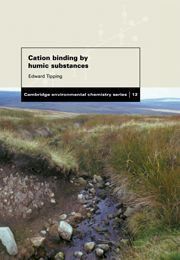Book contents
- Frontmatter
- Contents
- Preface
- 1 Introduction
- 2 Humic substances – a brief review
- 3 Environmental solution and surface chemistry
- 4 Proton dissociation from weak acids
- 5 Metal–ligand interactions
- 6 Methods for measuring cation binding by humic substances
- 7 Quantitative results with isolated humic substances
- 8 Cation binding sites in humic substances
- 9 Parameterised models of cation–humic interactions
- 10 Applications of comprehensive parameterised models
- 11 Predictive modelling
- 12 Cation–humic binding and other physico-chemical processes
- 13 Cation binding by humic substances in natural waters
- 14 Cation binding by humic substances in soils and sediments
- 15 Research needs
- References
- Index
7 - Quantitative results with isolated humic substances
Published online by Cambridge University Press: 18 August 2009
- Frontmatter
- Contents
- Preface
- 1 Introduction
- 2 Humic substances – a brief review
- 3 Environmental solution and surface chemistry
- 4 Proton dissociation from weak acids
- 5 Metal–ligand interactions
- 6 Methods for measuring cation binding by humic substances
- 7 Quantitative results with isolated humic substances
- 8 Cation binding sites in humic substances
- 9 Parameterised models of cation–humic interactions
- 10 Applications of comprehensive parameterised models
- 11 Predictive modelling
- 12 Cation–humic binding and other physico-chemical processes
- 13 Cation binding by humic substances in natural waters
- 14 Cation binding by humic substances in soils and sediments
- 15 Research needs
- References
- Index
Summary
We now consider the results of experimental studies in which extents of interaction of protons and metal ions with humic substances have been determined. The emphasis is on amounts of binding, rather than the qualitative nature of the complexes, which is dealt with in Chapter 8. The review material is not exhaustive, but key examples are given to cover the present state of knowledge. Some simple interpretations are offered, to prepare the ground for Chapters 9–11, which deal with modelling. The ‘isolated’ appears in the chapter title because only results with isolated materials are considered; results from field samples are discussed in Chapters 13 and 14.
Proton dissociation
Titration curves for humic substances
Some results have already been presented in Chapter 4, including comparisons with simple ligands and polyacids. More data are plotted in Fig. 7.1. As has been noted before, the plots of Z vs. pH are rather featureless, with only suggestions of an end-point around neutral pH. Also, there is an appreciable effect of ionic strength, which is greater for humic acid than for fulvic acid, but in both cases less than for high molecular weight polyprotic acids. As mentioned in Chapter 4, the results can be interpreted in terms of a combination of (a) Coulombic effects, which give the ionic-strength dependence and cause some of the ‘smearing’ of the titration curves, and (b) site heterogeneity. The exact contributions of the two factors are difficult to extract from the experimental data.
Information
- Type
- Chapter
- Information
- Cation Binding by Humic Substances , pp. 128 - 156Publisher: Cambridge University PressPrint publication year: 2002
